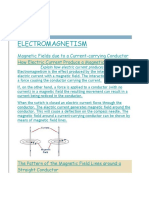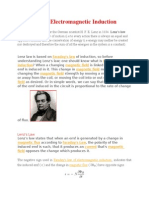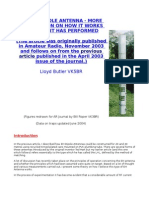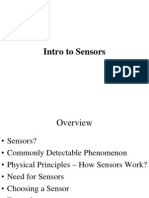Notebook 5
Notebook 5
Uploaded by
api-340425056Copyright:
Available Formats
Notebook 5
Notebook 5
Uploaded by
api-340425056Original Title
Copyright
Available Formats
Share this document
Did you find this document useful?
Is this content inappropriate?
Copyright:
Available Formats
Notebook 5
Notebook 5
Uploaded by
api-340425056Copyright:
Available Formats
Notebook 5
Flemings Hand Rules
There are several hand rules that are quite useful for remembering various electromagnetic
relationships and they are divided into four groups:
1.
2.
3.
4.
Hand thumb rules along a conductor
Hand thumb rules for solenoid and electromagnetic poles
Hand generator effect rules
Hand motor principle rules
It is important to know that the hand rules that are based on current flow (conventional current
direction) and the hand flows that are based on electron flow (actual direction of electron
movement) will be the EXACT opposite.
The four rules are explained below:
Flemings Right Hand Thumb Rule
Flemings right hand thumb rule states that if the right hand is used to grasp a conducting wire
with the thumb in the direction of the current flow, the fingers will indicate the direction of the
magnetic field lines of force surrounding the conductor
Flemings Right Hand Solenoid and Electromagnetic Rule
In this rule, the thumb is the direction of north pole and the fingers are conventional current or
electron flow. When a conductor is looped to form a coil, the magnetic fields from both sides
join to double the magnetic field strength inside the loop. A solenoid is a helix coil through
which current is flowing; it uses the coil loops to produce a greatly strengthened magnetic field.
Flemings Right Hand Generator Rule
Flemings Right Hand Rule is used when you are referring to generators. This rule states that if
the thumb points in the direction the conductor (or armature) is moving and the index finger
points in the direction of the magnetic lines of force field, then the middle finger will indicate
the direction of the conventional current.
10
Flemings Left Hand Motor Rule
Flemings left hand rule is used when referring to motors. The rule states that if the index finger
points in the direction of the magnetic lines of force field and the middle finger points in the
direction of the conventional current, the thumb will indicate the direction that the conductor
will move. So,
The Relationship between Electricity and Magnets
Magnetic fields are produced by moving charges, current, and moving charges are
affected by magnets.
Any moving charge produces a magnetic field
When current flows in a conductor, a magnetic field is created around the conductor
As current goes up, so does the magnetic field strength. Conversely, a magnetic field in
motion creates electric current
Electrical current can generate a magnetic field.
There are three ways to create the motion between lines of force and a conductor
1. Move the conductor through a stationary, unchanging-strength magnetic field.
2. Move magnetic lines of force through a stationary conductor with an
unchanging-strength magnetic field
3. Vary the magnetic flux strength from a stationary magnet through a stationary
conductor. As the flux strength varies, the lines of force will expand and contract,
in effect causing the relative motion necessary to induce current.
11
You might also like
- Topic 4 Electromagnetic Effects PDFDocument10 pagesTopic 4 Electromagnetic Effects PDFHakim Abbas Ali PhalasiyaNo ratings yet
- Physics Project Class 10 Magnetic Effect of Electric Current Class NotesDocument14 pagesPhysics Project Class 10 Magnetic Effect of Electric Current Class NotesAjay RawatNo ratings yet
- FOE Question Bank Unit-2 SolutionsDocument27 pagesFOE Question Bank Unit-2 SolutionsphotosofthkNo ratings yet
- Elmachi1 - Lecture7 (Electrical Machines - Part 2)Document12 pagesElmachi1 - Lecture7 (Electrical Machines - Part 2)Trisha SARMIENTONo ratings yet
- Attachment PHPDocument7 pagesAttachment PHPKunal Bagade.No ratings yet
- Phy Topic 2 F4Document12 pagesPhy Topic 2 F4Kandrossy GlassNo ratings yet
- Notebook 5Document5 pagesNotebook 5api-334252501No ratings yet
- 3.2 Understanding The Force On A Current-Carrying Conductor in A Magnetic Field.Document32 pages3.2 Understanding The Force On A Current-Carrying Conductor in A Magnetic Field.Ishraqi IlyasNo ratings yet
- CBSE Class 10 Science Revision Notes Chapter - 13 Magnetic Effects of Electric CurrentDocument13 pagesCBSE Class 10 Science Revision Notes Chapter - 13 Magnetic Effects of Electric CurrentkunalNo ratings yet
- Dow 00068Document150 pagesDow 00068Kunal Bagade.No ratings yet
- Magnetic Effects of Electric CurrentDocument3 pagesMagnetic Effects of Electric CurrentRounak BasuNo ratings yet
- DC Motor: Assignment 5Document10 pagesDC Motor: Assignment 5Renz MykoNo ratings yet
- Notes_MagnetismDocument3 pagesNotes_Magnetismvini717No ratings yet
- Fleming Left Hand RuleDocument2 pagesFleming Left Hand Rulethangamuthu baskarNo ratings yet
- Fleming's Left-Hand Rule For Motors: From Wikipedia, The Free EncyclopediaDocument9 pagesFleming's Left-Hand Rule For Motors: From Wikipedia, The Free EncyclopediaSamip TripathyNo ratings yet
- Form5 Electromagnetic 120725095923 Phpapp02Document39 pagesForm5 Electromagnetic 120725095923 Phpapp02newdirextionNo ratings yet
- ElecrtomagnetismDocument12 pagesElecrtomagnetismFatin Nurhakimah AliaNo ratings yet
- Chapter 3: Electromagnetism: Magnetic Field PatternDocument29 pagesChapter 3: Electromagnetism: Magnetic Field PatternNur ArafahNo ratings yet
- ElectromagnetismDocument22 pagesElectromagnetismaaminarushdy231No ratings yet
- Grade 10 Magnetic Effects of Current: Magnetic Field Lines (Properties) 1. 2. 3. 4Document3 pagesGrade 10 Magnetic Effects of Current: Magnetic Field Lines (Properties) 1. 2. 3. 422550No ratings yet
- State Whether The Following Statements Are True or FalseDocument11 pagesState Whether The Following Statements Are True or Falsearohi90% (1)
- Electromagnetic Induction LecturesDocument9 pagesElectromagnetic Induction LecturesDoyen DanielNo ratings yet
- CBSE Class 10 Science Notes Chapter 13 Magnetic Effects of Electric CurrentDocument13 pagesCBSE Class 10 Science Notes Chapter 13 Magnetic Effects of Electric Currentdrphysics256No ratings yet
- Motors Study SheetDocument5 pagesMotors Study SheetDalia SaqqaNo ratings yet
- Chapter 15 CompleteDocument22 pagesChapter 15 Completemalik.ahsan26992No ratings yet
- Electromagnetic FieldDocument11 pagesElectromagnetic FieldonukaogustephanieNo ratings yet
- Physics - ElectromagnetismDocument3 pagesPhysics - ElectromagnetismMegan TaylorNo ratings yet
- Faraday's & Lenz LawDocument14 pagesFaraday's & Lenz LawPnDeNo ratings yet
- PhysicsDocument3 pagesPhysicsMohit TiwariNo ratings yet
- Class X Science (Magnetic Effect of Electric Current)Document10 pagesClass X Science (Magnetic Effect of Electric Current)Mohammad RezaullahNo ratings yet
- Answers Magnetic EffectsDocument2 pagesAnswers Magnetic Effectslisten2tubeNo ratings yet
- CH 13 Magnetic Effects of Electric Current NotesDocument12 pagesCH 13 Magnetic Effects of Electric Current NotesAkshithNo ratings yet
- Magnetic Effects of Electric CurrentDocument17 pagesMagnetic Effects of Electric CurrentKunalKaushik100% (3)
- Elect Roma Gneti SM: How Electric Current Produce A Magnetic FieldDocument8 pagesElect Roma Gneti SM: How Electric Current Produce A Magnetic FieldIsmail MzavaNo ratings yet
- Electromgnetic InductionDocument5 pagesElectromgnetic InductionGhanshyam SinghNo ratings yet
- Lenz Law For DCDocument5 pagesLenz Law For DCGenette AringoNo ratings yet
- Notes For Magnetic Effects of Electric CurrentDocument9 pagesNotes For Magnetic Effects of Electric Currenttanishq.sonar03No ratings yet
- Magnetic Effect of A CurrentDocument13 pagesMagnetic Effect of A CurrentosunfisanayomideNo ratings yet
- Gym G8 Gzqmu Er BXZG GJ SFDocument6 pagesGym G8 Gzqmu Er BXZG GJ SFDipesh SherdiwalaNo ratings yet
- EM6 Magnetic Effects of CurrentDocument3 pagesEM6 Magnetic Effects of CurrentnonofotlhoweNo ratings yet
- 8 Ir 41 PF VOg WVT ELd Zy 7 T FA!!Document1 page8 Ir 41 PF VOg WVT ELd Zy 7 T FA!!adhitya0006No ratings yet
- Faraday's Law of Electromagnetic Induction: Fleming's Right Hand RuleDocument16 pagesFaraday's Law of Electromagnetic Induction: Fleming's Right Hand RuleMahesh Kumar SahNo ratings yet
- Magnetic Effects of Electric CurrentDocument27 pagesMagnetic Effects of Electric CurrentMIN. Dr. Tanaji sawant officeNo ratings yet
- Lenz LawDocument4 pagesLenz LawWilliam Simms0% (1)
- Magnetism and Electromagnetism: Learning OutcomeDocument14 pagesMagnetism and Electromagnetism: Learning OutcomeMandeep MalikNo ratings yet
- Magnetic FieldDocument19 pagesMagnetic FieldNitinSrivastava100% (2)
- Magnetic Effect of CurrentDocument7 pagesMagnetic Effect of CurrentgoyalnahveNo ratings yet
- 4.2 Electromagnetic Induction 2024 1 - 46Document46 pages4.2 Electromagnetic Induction 2024 1 - 46Park JongseongNo ratings yet
- Magnetic Effect of Current Class 10thDocument13 pagesMagnetic Effect of Current Class 10thMack TripathiNo ratings yet
- 3-5 Physics Elec MagDocument34 pages3-5 Physics Elec MagPrecious BalgunaNo ratings yet
- Chapter 10 Magnetic Effect of CurrentDocument5 pagesChapter 10 Magnetic Effect of Currenty.k.allolahNo ratings yet
- Chapter - 1 G9 Term 3Document23 pagesChapter - 1 G9 Term 3Stunt BroNo ratings yet
- Ac Circuits L1Document10 pagesAc Circuits L1apshardaNo ratings yet
- How Do Electric Motors Work? Physics Books for Kids | Children's Physics BooksFrom EverandHow Do Electric Motors Work? Physics Books for Kids | Children's Physics BooksNo ratings yet
- Complete Electronics Self-Teaching Guide with ProjectsFrom EverandComplete Electronics Self-Teaching Guide with ProjectsRating: 3 out of 5 stars3/5 (2)
- EightDocument10 pagesEightapi-340425056No ratings yet
- ElevenDocument11 pagesElevenapi-340425056No ratings yet
- NineDocument4 pagesNineapi-340425056No ratings yet
- FiveDocument5 pagesFiveapi-340425056No ratings yet
- SevenDocument5 pagesSevenapi-340425056No ratings yet
- ThreeDocument6 pagesThreeapi-340425056No ratings yet
- TableofcontentsDocument1 pageTableofcontentsapi-340425056No ratings yet
- Notebook 12Document2 pagesNotebook 12api-340425056No ratings yet
- Notebook 10Document2 pagesNotebook 10api-340425056No ratings yet
- Notebook 8Document2 pagesNotebook 8api-340425056No ratings yet
- Notebook 9Document1 pageNotebook 9api-340425056No ratings yet
- Notebook 3Document2 pagesNotebook 3api-340425056No ratings yet
- Notebook 6Document2 pagesNotebook 6api-340425056No ratings yet
- Notebook 1Document2 pagesNotebook 1api-340425056No ratings yet
- Notebook 2Document1 pageNotebook 2api-340425056No ratings yet
- Neodymium Magnets 1Document25 pagesNeodymium Magnets 1John Paul Patungan100% (1)
- Rating of Circuit BreakerDocument10 pagesRating of Circuit BreakerhanifinsanNo ratings yet
- Capacitive Current SwitchingDocument4 pagesCapacitive Current SwitchingChandramouli RajagopalanNo ratings yet
- Chapter 29.magneticDocument23 pagesChapter 29.magneticOsama Hassan100% (1)
- Induction Furnace Working Principle - Mechanical EngineeringDocument5 pagesInduction Furnace Working Principle - Mechanical Engineeringjalilemadi0% (1)
- 021 - Aircraft General KnowledgeDocument6 pages021 - Aircraft General KnowledgeUvin Ranaweera0% (1)
- System Design Engineering 2015 E5 3 Study of The Behaviour of A N Metal Cable Screen Subject To Adiabatic Short CircuitDocument4 pagesSystem Design Engineering 2015 E5 3 Study of The Behaviour of A N Metal Cable Screen Subject To Adiabatic Short CircuitLoulhs ParlapipievitsNo ratings yet
- UT Book - Articles PDFDocument135 pagesUT Book - Articles PDFAnonymous uXdS9Y7100% (4)
- UCM QUESTION BANK-min PDFDocument20 pagesUCM QUESTION BANK-min PDFBalaNo ratings yet
- Vk5br Eh Dipole AntennaDocument12 pagesVk5br Eh Dipole AntennaInsafe El WakiliNo ratings yet
- Thomson CoilDocument10 pagesThomson CoilSimonidaPuhalo100% (1)
- 118CP Selection of CP Systems For Reinforced Concrete StructuresDocument15 pages118CP Selection of CP Systems For Reinforced Concrete StructuresWill NashNo ratings yet
- The Philippine Electronics CodeDocument3 pagesThe Philippine Electronics CodeShairah Anne Gonzales LobatonNo ratings yet
- ACS102-6T: AC Switch Family Transient Protected AC Switch (ACS™)Document11 pagesACS102-6T: AC Switch Family Transient Protected AC Switch (ACS™)teguhscribdNo ratings yet
- Physics XII CombinedDocument556 pagesPhysics XII CombinedRamya PothurNo ratings yet
- Notes On Maintenance of TransformersDocument19 pagesNotes On Maintenance of Transformersamer4411100% (2)
- Electromagnetism Mind MapDocument1 pageElectromagnetism Mind Mapmaxine janorasNo ratings yet
- Topic 4 CIE Physics IGCSE-mergedDocument16 pagesTopic 4 CIE Physics IGCSE-mergedtasheenuzzaman313No ratings yet
- Sensors IntroductionDocument25 pagesSensors IntroductionrR2CcNo ratings yet
- Magnetron Power Supply SpecDocument2 pagesMagnetron Power Supply SpecMeghjit MazumderNo ratings yet
- Review: Lei GuanDocument10 pagesReview: Lei Guanamit261287No ratings yet
- Cathodic Protection DesignDocument34 pagesCathodic Protection DesignSuliman Sudani100% (2)
- Chapter I - ElectrolysisDocument41 pagesChapter I - ElectrolysisRodella ChowdhuryNo ratings yet
- DC Generator Efficiency PDFDocument18 pagesDC Generator Efficiency PDFwatanoshiNo ratings yet
- Nema SM 24 1991 R2002Document93 pagesNema SM 24 1991 R2002surawutwijarn100% (2)
- StaelinDocument443 pagesStaelinWilliam Marques100% (2)
- Direct CurrentDocument17 pagesDirect CurrentSyukur GuloNo ratings yet
- Catu Daya 723Document6 pagesCatu Daya 723Audi MirantiNo ratings yet
- Basic Electrical Engineering & Circuit Theory Laws: By: Engr. Edwin C. EspinasDocument111 pagesBasic Electrical Engineering & Circuit Theory Laws: By: Engr. Edwin C. EspinasKenneth LorenzoNo ratings yet







































































































